mirror BMW 1 SERIES 2010 User Guide
[x] Cancel search | Manufacturer: BMW, Model Year: 2010, Model line: 1 SERIES, Model: BMW 1 SERIES 2010Pages: 166, PDF Size: 5.31 MB
Page 79 of 166
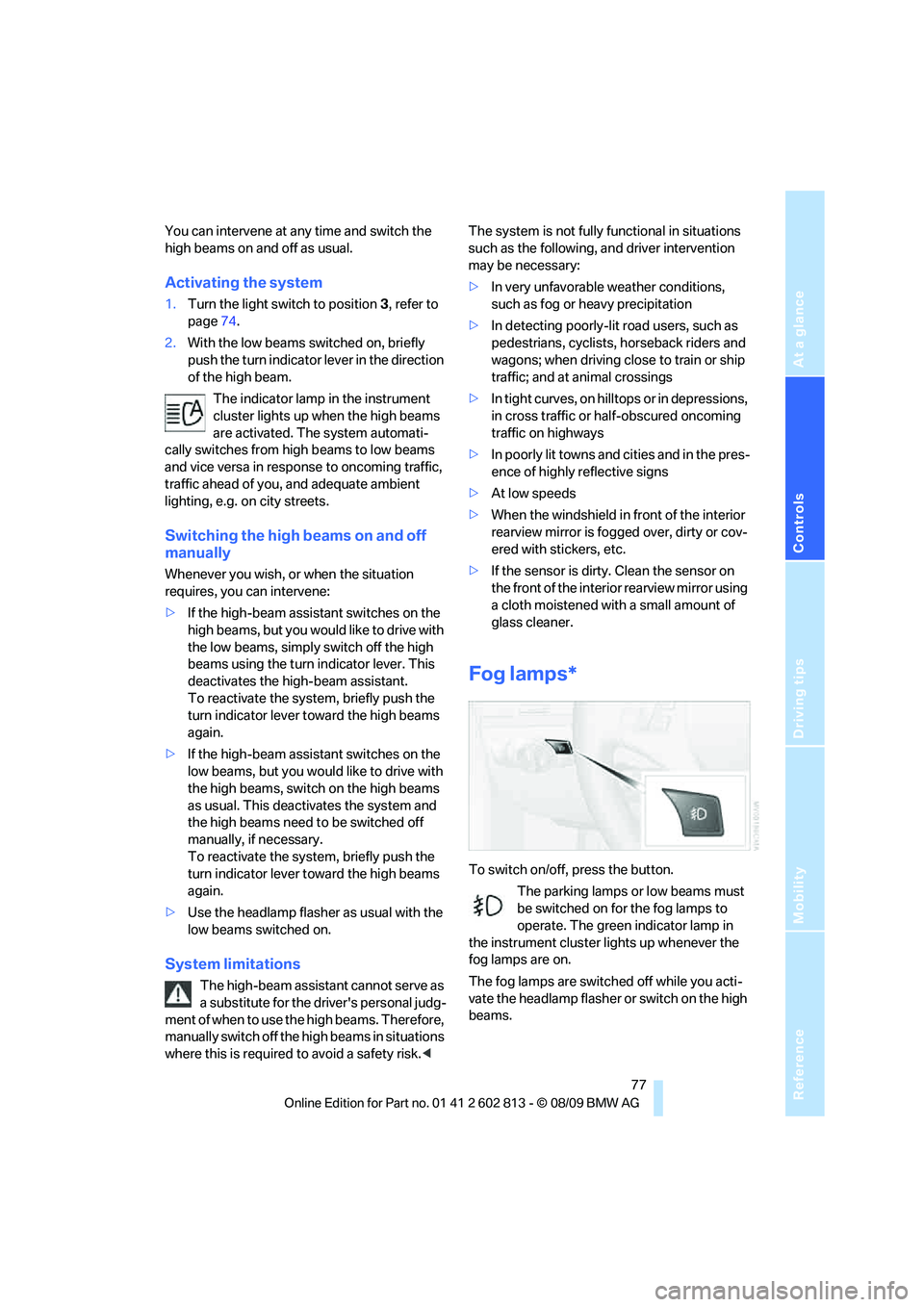
Reference
At a glance
Controls
Driving tips
Mobility
77
You can intervene at any time and switch the
high beams on and off as usual.
Activating the system
1.Turn the light switch to position3, refer to
page74.
2.With the low beams switched on, briefly
push the turn indicator lever in the direction
of the high beam.
The indicator lamp in the instrument
cluster lights up when the high beams
are activated. The system automati-
cally switches from high beams to low beams
and vice versa in response to oncoming traffic,
traffic ahead of you, and adequate ambient
lighting, e.g. on city streets.
Switching the high beams on and off
manually
Whenever you wish, or when the situation
requires, you can intervene:
>If the high-beam assistant switches on the
high beams, but you would like to drive with
the low beams, simply switch off the high
beams using the turn indicator lever. This
deactivates the high-beam assistant.
To reactivate the system, briefly push the
turn indicator lever toward the high beams
again.
>If the high-beam assistant switches on the
low beams, but you would like to drive with
the high beams, switch on the high beams
as usual. This deactivates the system and
the high beams need to be switched off
manually, if necessary.
To reactivate the system, briefly push the
turn indicator lever toward the high beams
again.
>Use the headlamp flasher as usual with the
low beams switched on.
System limitations
The high-beam assistant cannot serve as
a substitute for the driver's personal judg-
ment of when to use the high beams. Therefore,
manually switch off the high beams in situations
where this is required to avoid a safety risk.
may be necessary:
>In very unfavorable weather conditions,
such as fog or heavy precipitation
>In detecting poorly-lit road users, such as
pedestrians, cyclists, horseback riders and
wagons; when driving close to train or ship
traffic; and at animal crossings
>In tight curves, on hilltops or in depressions,
in cross traffic or half-obscured oncoming
traffic on highways
>In poorly lit towns and cities and in the pres-
ence of highly reflective signs
>At low speeds
>When the windshield in front of the interior
rearview mirror is fogged over, dirty or cov-
ered with stickers, etc.
>If the sensor is dirty. Clean the sensor on
the front of the interior rearview mirror using
a cloth moistened with a small amount of
glass cleaner.
Fog lamps*
To switch on/off, press the button.
The parking lamps or low beams must
be switched on for the fog lamps to
operate. The green indicator lamp in
the instrument cluster lights up whenever the
fog lamps are on.
The fog lamps are switched off while you acti-
vate the headlamp flasher or switch on the high
beams.
Page 98 of 166
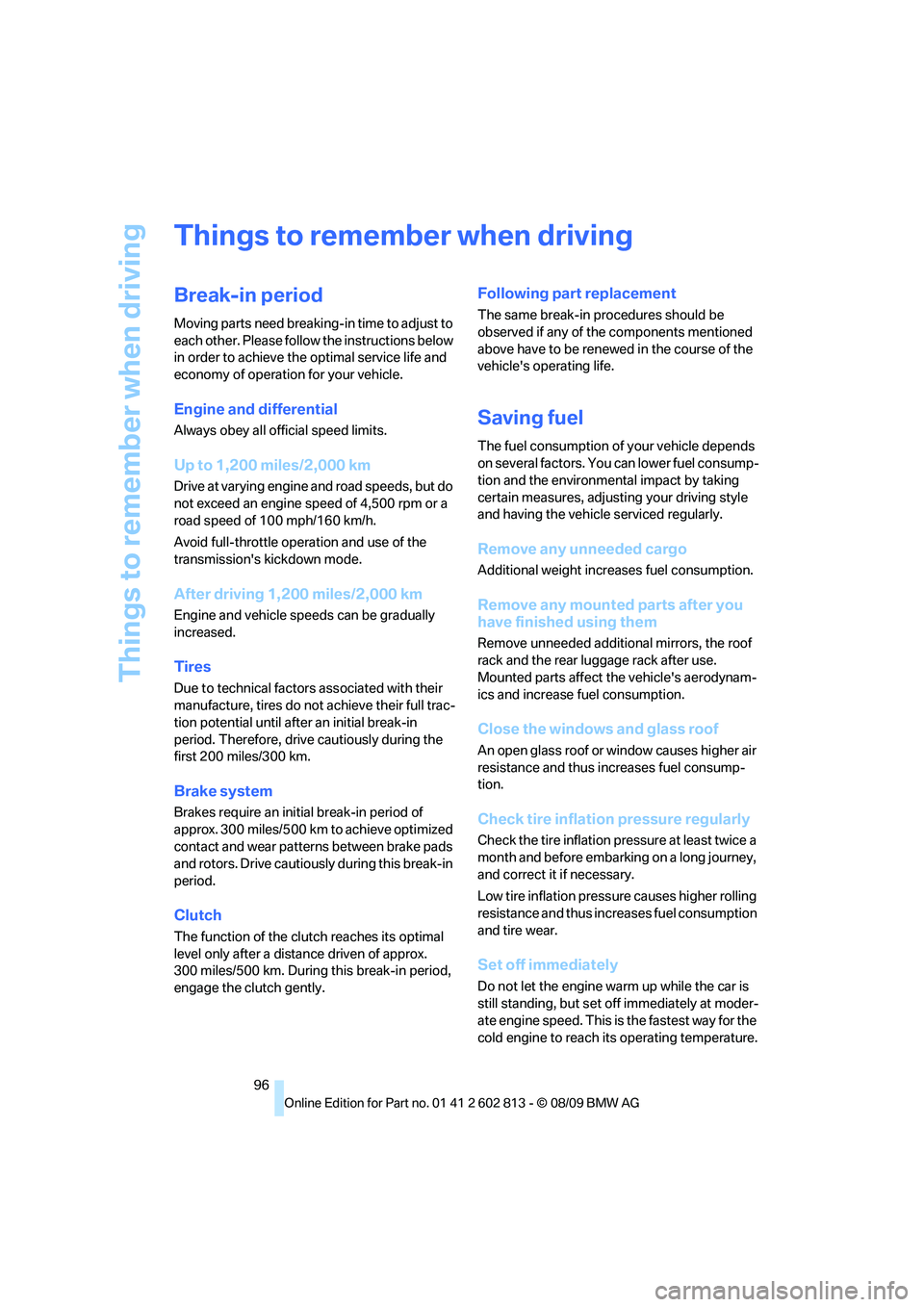
Things to remember when driving
96
Things to remember when driving
Break-in period
Moving parts need breaking-in time to adjust to
each other. Please follow the instructions below
in order to achieve the optimal service life and
economy of operation for your vehicle.
Engine and differential
Always obey all official speed limits.
Up to 1,200 miles/2,000 km
Drive at varying engine and road speeds, but do
not exceed an engine speed of 4,500 rpm or a
road speed of 100 mph/160 km/h.
Avoid full-throttle operation and use of the
transmission's kickdown mode.
After driving 1,200 miles/2,000 km
Engine and vehicle speeds can be gradually
increased.
Tires
Due to technical factors associated with their
manufacture, tires do not achieve their full trac-
tion potential until after an initial break-in
period. Therefore, drive cautiously during the
first 200 miles/300 km.
Brake system
Brakes require an initial break-in period of
approx. 300 miles/500 km to achieve optimized
contact and wear patterns between brake pads
and rotors. Drive cautiously during this break-in
period.
Clutch
The function of the clutch reaches its optimal
level only after a distance driven of approx.
300 miles/500 km. During this break-in period,
engage the clutch gently.
Following part replacement
The same break-in procedures should be
observed if any of the components mentioned
above have to be renewed in the course of the
vehicle's operating life.
Saving fuel
The fuel consumption of your vehicle depends
on several factors. You can lower fuel consump-
tion and the environmental impact by taking
certain measures, adjusting your driving style
and having the vehicle serviced regularly.
Remove any unneeded cargo
Additional weight increases fuel consumption.
Remove any mounted parts after you
have finished using them
Remove unneeded additional mirrors, the roof
rack and the rear luggage rack after use.
Mounted parts affect the vehicle's aerodynam-
ics and increase fuel consumption.
Close the windows and glass roof
An open glass roof or window causes higher air
resistance and thus increases fuel consump-
tion.
Check tire inflation pressure regularly
Check the tire inflation pressure at least twice a
month and before embarking on a long journey,
and correct it if necessary.
Low tire inflation pressure causes higher rolling
resistance and thus increases fuel consumption
and tire wear.
Set off immediately
Do not let the engine warm up while the car is
still standing, but set off immediately at moder-
ate engine speed. This is the fastest way for the
cold engine to reach its operating temperature.
Page 122 of 166
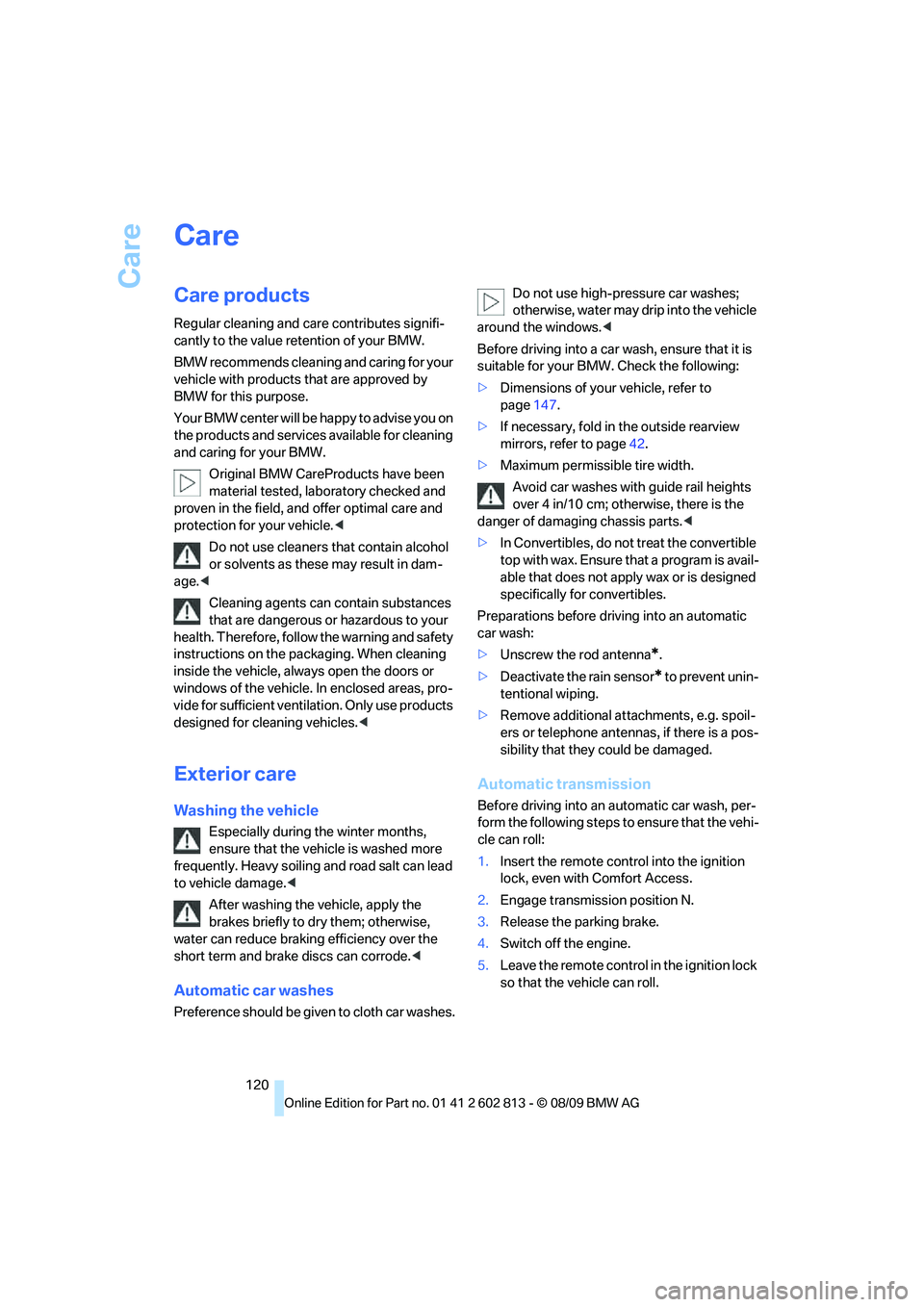
Care
120
Care
Care products
Regular cleaning and care contributes signifi-
cantly to the value retention of your BMW.
BMW recommends cleaning and caring for your
vehicle with products that are approved by
BMW for this purpose.
Your BMW center will be happy to advise you on
the products and services available for cleaning
and caring for your BMW.
Original BMW CareProducts have been
material tested, laboratory checked and
proven in the field, and offer optimal care and
protection for your vehicle.<
Do not use cleaners that contain alcohol
or solvents as these may result in dam-
age.<
Cleaning agents can contain substances
that are dangerous or hazardous to your
health. Therefore, follow the warning and safety
instructions on the packaging. When cleaning
inside the vehicle, always open the doors or
windows of the vehicle. In enclosed areas, pro-
vide for sufficient ventilation. Only use products
designed for cleaning vehicles.<
Exterior care
Washing the vehicle
Especially during the winter months,
ensure that the vehicle is washed more
frequently. Heavy soiling and road salt can lead
to vehicle damage.<
After washing the vehicle, apply the
brakes briefly to dry them; otherwise,
water can reduce braking efficiency over the
short term and brake discs can corrode.<
Automatic car washes
Preference should be given to cloth car washes.Do not use high-pressure car washes;
otherwise, water may drip into the vehicle
around the windows.<
Before driving into a car wash, ensure that it is
suitable for your BMW. Check the following:
>Dimensions of your vehicle, refer to
page147.
>If necessary, fold in the outside rearview
mirrors, refer to page42.
>Maximum permissible tire width.
Avoid car washes with guide rail heights
over 4 in/10 cm; otherwise, there is the
danger of damaging chassis parts.<
>In Convertibles, do not treat the convertible
top with wax. Ensure that a program is avail-
able that does not apply wax or is designed
specifically for convertibles.
Preparations before driving into an automatic
car wash:
>Unscrew the rod antenna
*.
>Deactivate the rain sensor
* to prevent unin-
tentional wiping.
>Remove additional attachments, e.g. spoil-
ers or telephone antennas, if there is a pos-
sibility that they could be damaged.
Automatic transmission
Before driving into an automatic car wash, per-
form the following steps to ensure that the vehi-
cle can roll:
1.Insert the remote control into the ignition
lock, even with Comfort Access.
2.Engage transmission position N.
3.Release the parking brake.
4.Switch off the engine.
5.Leave the remote control in the ignition lock
so that the vehicle can roll.
Page 123 of 166
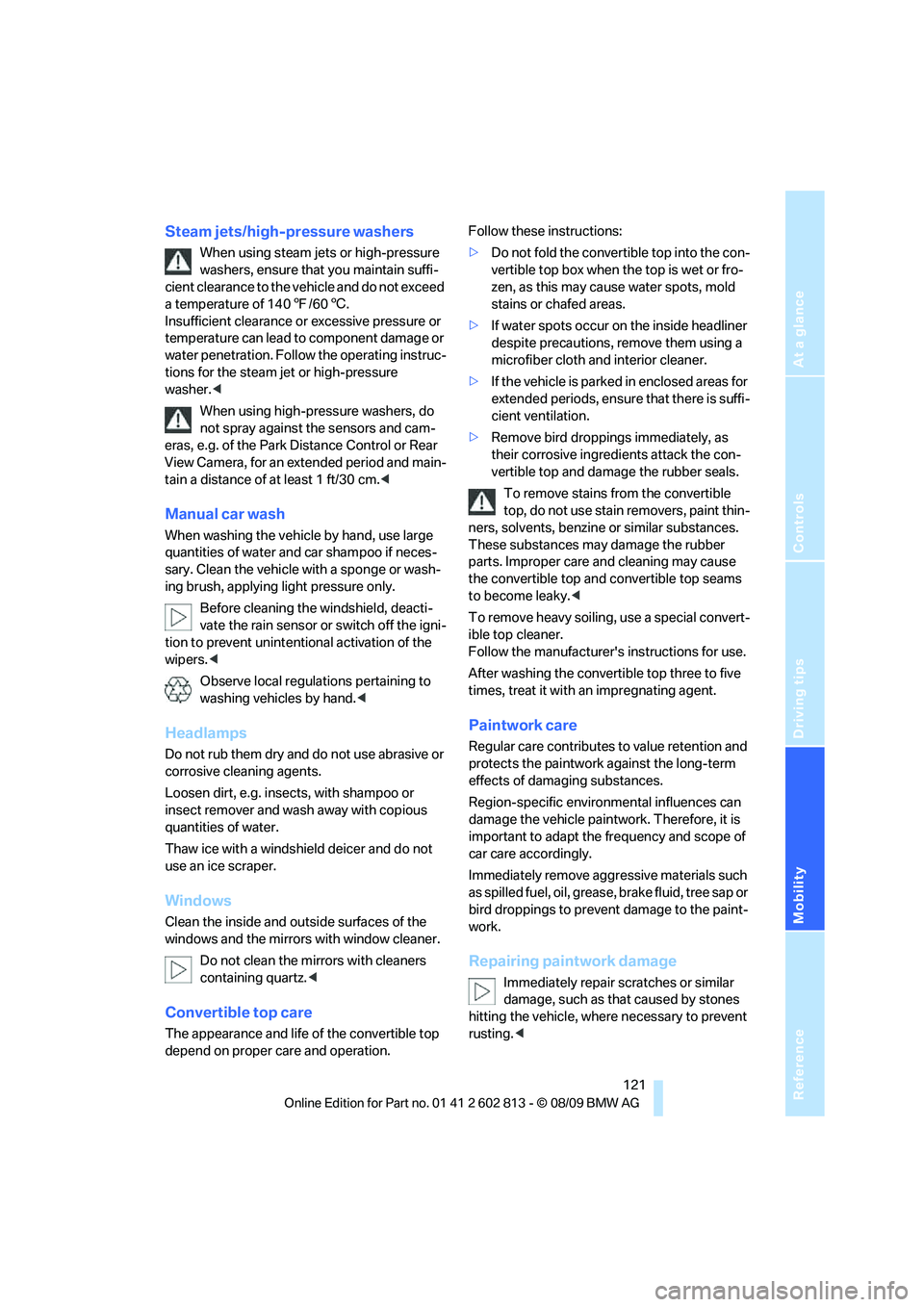
Reference
At a glance
Controls
Driving tips
Mobility
121
Steam jets/high-pressure washers
When using steam jets or high-pressure
washers, ensure that you maintain suffi-
cient clearance to the vehicle and do not exceed
a temperature of 1407/606.
Insufficient clearance or excessive pressure or
temperature can lead to component damage or
water penetration. Follow the operating instruc-
tions for the steam jet or high-pressure
washer.<
When using high-pressure washers, do
not spray against the sensors and cam-
eras, e.g. of the Park Distance Control or Rear
View Camera, for an extended period and main-
tain a distance of at least 1 ft/30 cm.<
Manual car wash
When washing the vehicle by hand, use large
quantities of water and car shampoo if neces-
sary. Clean the vehicle with a sponge or wash-
ing brush, applying light pressure only.
Before cleaning the windshield, deacti-
vate the rain sensor or switch off the igni-
tion to prevent unintentional activation of the
wipers.<
Observe local regulations pertaining to
washing vehicles by hand.<
Headlamps
Do not rub them dry and do not use abrasive or
corrosive cleaning agents.
Loosen dirt, e.g. insects, with shampoo or
insect remover and wash away with copious
quantities of water.
Thaw ice with a windshield deicer and do not
use an ice scraper.
Windows
Clean the inside and outside surfaces of the
windows and the mirrors with window cleaner.
Do not clean the mirrors with cleaners
containing quartz.<
Convertible top care
The appearance and life of the convertible top
depend on proper care and operation.Follow these instructions:
>Do not fold the convertible top into the con-
vertible top box when the top is wet or fro-
zen, as this may cause water spots, mold
stains or chafed areas.
>If water spots occur on the inside headliner
despite precautions, remove them using a
microfiber cloth and interior cleaner.
>If the vehicle is parked in enclosed areas for
extended periods, ensure that there is suffi-
cient ventilation.
>Remove bird droppings immediately, as
their corrosive ingredients attack the con-
vertible top and damage the rubber seals.
To remove stains from the convertible
top, do not use stain removers, paint thin-
ners, solvents, benzine or similar substances.
These substances may damage the rubber
parts. Improper care and cleaning may cause
the convertible top and convertible top seams
to become leaky.<
To remove heavy soiling, use a special convert-
ible top cleaner.
Follow the manufacturer's instructions for use.
After washing the convertible top three to five
times, treat it with an impregnating agent.
Paintwork care
Regular care contributes to value retention and
protects the paintwork against the long-term
effects of damaging substances.
Region-specific environmental influences can
damage the vehicle paintwork. Therefore, it is
important to adapt the frequency and scope of
car care accordingly.
Immediately remove aggressive materials such
as spilled fuel, oil, grease, brake fluid, tree sap or
bird droppings to prevent damage to the paint-
work.
Repairing paintwork damage
Immediately repair scratches or similar
damage, such as that caused by stones
hitting the vehicle, where necessary to prevent
rusting.<
Page 130 of 166
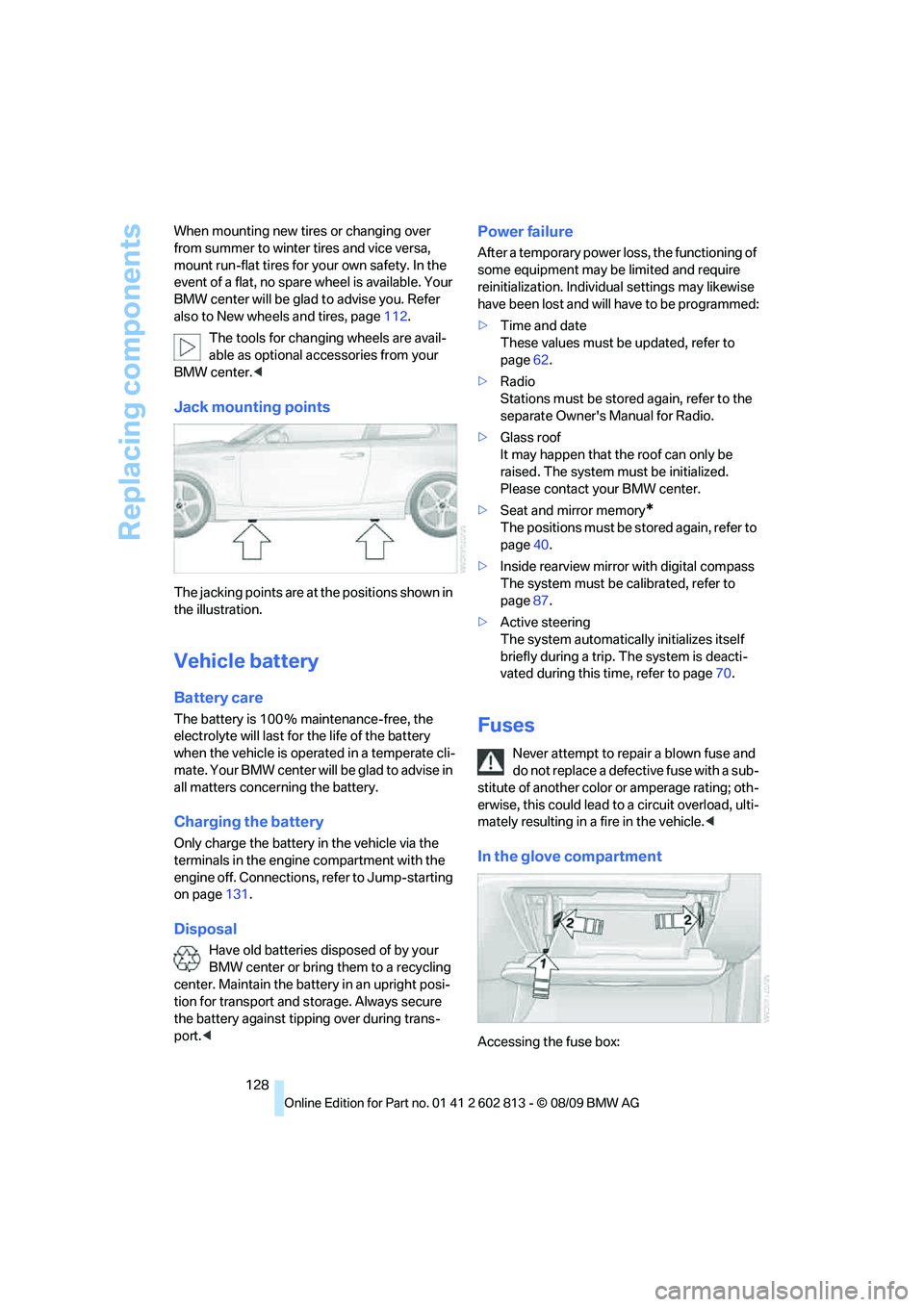
Replacing components
128 When mounting new tires or changing over
from summer to winter tires and vice versa,
mount run-flat tires for your own safety. In the
event of a flat, no spare wheel is available. Your
BMW center will be glad to advise you. Refer
also to New wheels and tires, page112.
The tools for changing wheels are avail-
able as optional accessories from your
BMW center.<
Jack mounting points
The jacking points are at the positions shown in
the illustration.
Vehicle battery
Battery care
The battery is 100 % maintenance-free, the
electrolyte will last for the life of the battery
when the vehicle is operated in a temperate cli-
ma te. Your BM W center will be glad to advise in
all matters concerning the battery.
Charging the battery
Only charge the battery in the vehicle via the
terminals in the engine compartment with the
engine off. Connections, refer to Jump-starting
on page131.
Disposal
Have old batteries disposed of by your
BMW center or bring them to a recycling
center. Maintain the battery in an upright posi-
tion for transport and storage. Always secure
the battery against tipping over during trans-
port.<
Power failure
After a temporary power loss, the functioning of
some equipment may be limited and require
reinitialization. Individual settings may likewise
have been lost and will have to be programmed:
>Time and date
These values must be updated, refer to
page62.
>Radio
Stations must be stored again, refer to the
separate Owner's Manual for Radio.
>Glass roof
It may happen that the roof can only be
raised. The system must be initialized.
Please contact your BMW center.
>Seat and mirror memory
*
The positions must be stored again, refer to
page40.
>Inside rearview mirror with digital compass
The system must be calibrated, refer to
page87.
>Active steering
The system automatically initializes itself
briefly during a trip. The system is deacti-
vated during this time, refer to page70.
Fuses
Never attempt to repair a blown fuse and
do not replace a defective fuse with a sub-
stitute of another color or amperage rating; oth-
erwise, this could lead to a circuit overload, ulti-
mately resulting in a fire in the vehicle.<
In the glove compartment
Accessing the fuse box:
Page 144 of 166
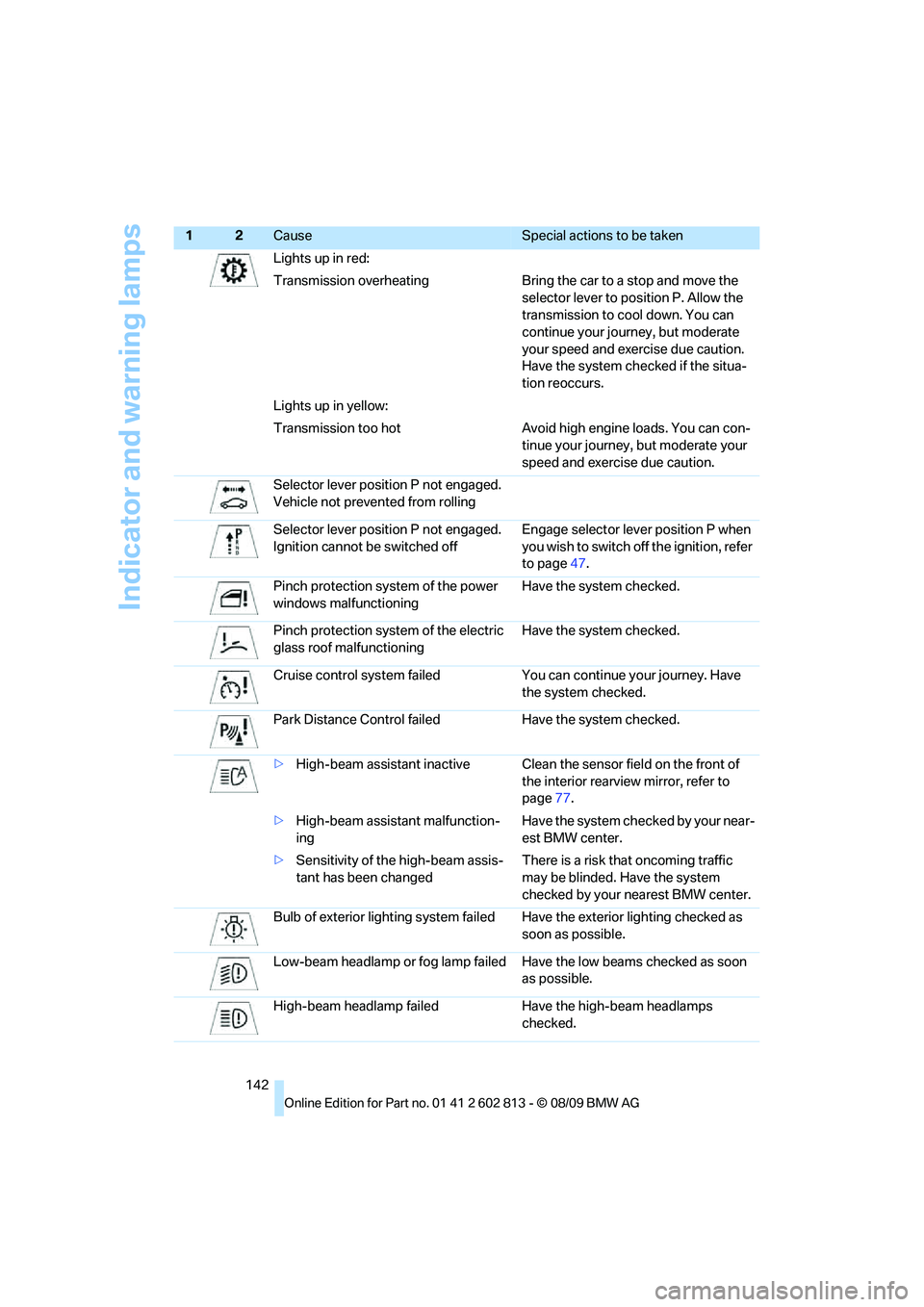
Indicator and warning lamps
142Lights up in red:
Transmission overheating Bring the car to a stop and move the
selector lever to position P. Allow the
transmission to cool down. You can
continue your journey, but moderate
your speed and exercise due caution.
Have the system checked if the situa-
tion reoccurs.
Lights up in yellow:
Transmission too hot Avoid high engine loads. You can con-
tinue your journey, but moderate your
speed and exercise due caution.
Selector lever position P not engaged.
Vehicle not prevented from rolling
Selector lever position P not engaged.
Ignition cannot be switched offEngage selector lever position P when
you wish to switch off the ignition, refer
to page47.
Pinch protection system of the power
windows malfunctioningHave the system checked.
Pinch protection system of the electric
glass roof malfunctioningHave the system checked.
Cruise control system failed You can continue your journey. Have
the system checked.
Park Distance Control failed Have the system checked.
>High-beam assistant inactive Clean the sensor field on the front of
the interior rearview mirror, refer to
page77.
>High-beam assistant malfunction-
ingHave the system checked by your near-
est BMW center.
>Sensitivity of the high-beam assis-
tant has been changedThere is a risk that oncoming traffic
may be blinded. Have the system
checked by your nearest BMW center.
Bulb of exterior lighting system failed Have the exterior lighting checked as
soon as possible.
Low-beam headlamp or fog lamp failed Have the low beams checked as soon
as possible.
High-beam headlamp failed Have the high-beam headlamps
checked.
12Cause Special actions to be taken
Page 157 of 166
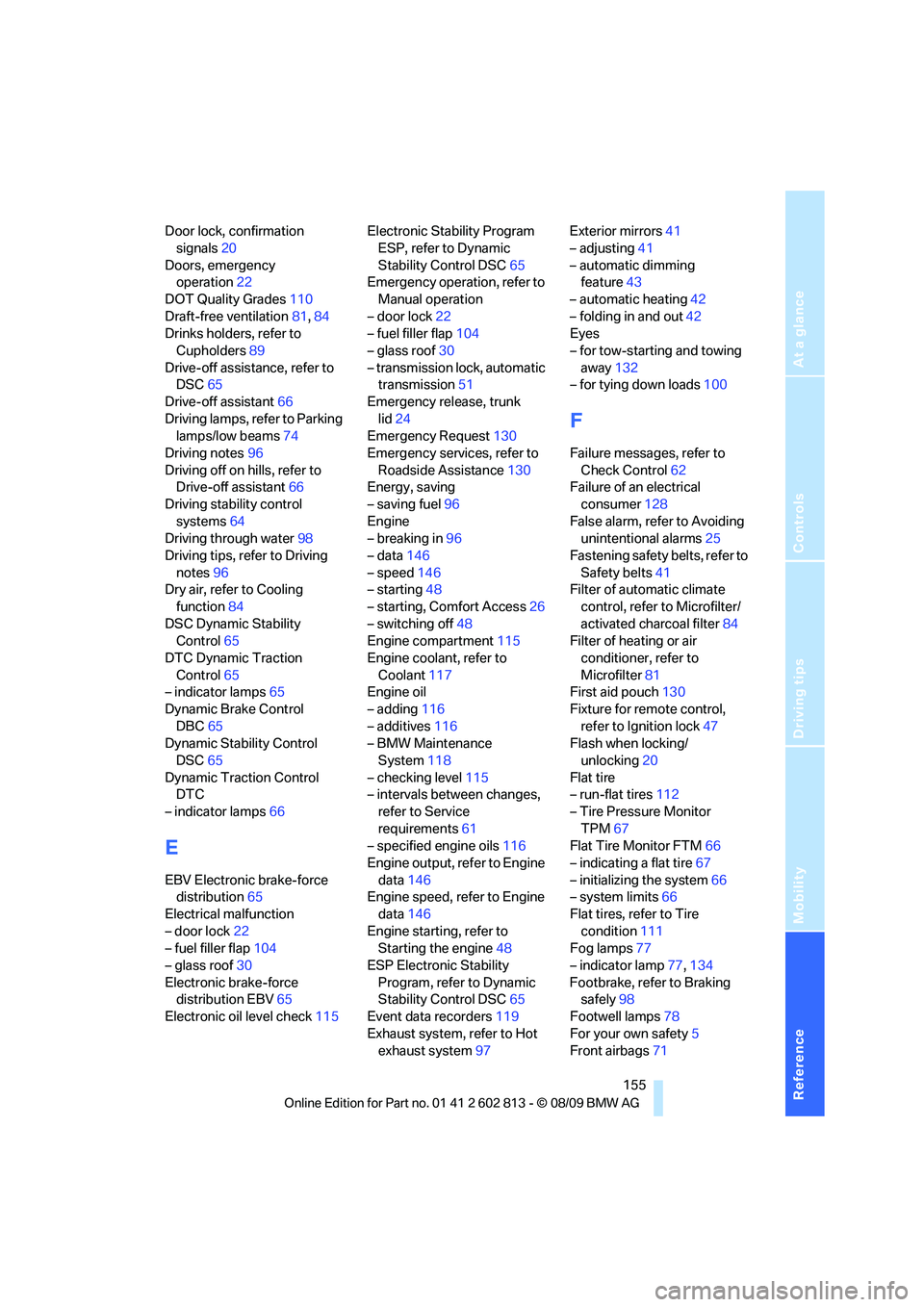
Reference
At a glance
Controls
Driving tips
Mobility
155
Door lock, confirmation
signals20
Doors, emergency
operation22
DOT Quality Grades110
Draft-free ventilation81,84
Drinks holders, refer to
Cupholders89
Drive-off assistance, refer to
DSC65
Drive-off assistant66
Driving lamps, refer to Parking
lamps/low beams74
Driving notes96
Driving off on hills, refer to
Drive-off assistant66
Driving stability control
systems64
Driving through water98
Driving tips, refer to Driving
notes96
Dry air, refer to Cooling
function84
DSC Dynamic Stability
Control65
DTC Dynamic Traction
Control65
– indicator lamps65
Dynamic Brake Control
DBC65
Dynamic Stability Control
DSC65
Dynamic Traction Control
DTC
– indicator lamps66
E
EBV Electronic brake-force
distribution65
Electrical malfunction
– door lock22
– fuel filler flap104
– glass roof30
Electronic brake-force
distribution EBV65
Electronic oil level check115Electronic Stability Program
ESP, refer to Dynamic
Stability Control DSC65
Emergency operation, refer to
Manual operation
– door lock22
– fuel filler flap104
– glass roof30
– transmission lock, automatic
transmission51
Emergency release, trunk
lid24
Emergency Request130
Emergency services, refer to
Roadside Assistance130
Energy, saving
– saving fuel96
Engine
– breaking in96
– data146
– speed146
– starting48
– starting, Comfort Access26
– switching off48
Engine compartment115
Engine coolant, refer to
Coolant117
Engine oil
– adding116
– additives116
– BMW Maintenance
System118
– checking level115
– intervals between changes,
refer to Service
requirements61
– specified engine oils116
Engine output, refer to Engine
data146
Engine speed, refer to Engine
data146
Engine starting, refer to
Starting the engine48
ESP Electronic Stability
Program, refer to Dynamic
Stability Control DSC65
Event data recorders119
Exhaust system, refer to Hot
exhaust system97Exterior mirrors41
– adjusting41
– automatic dimming
feature43
– automatic heating42
– folding in and out42
Eyes
– for tow-starting and towing
away132
– for tying down loads100
F
Failure messages, refer to
Check Control62
Failure of an electrical
consumer128
False alarm, refer to Avoiding
unintentional alarms25
Fastening safety belts, refer to
Safety belts41
Filter of automatic climate
control, refer to Microfilter/
activated charcoal filter84
Filter of heating or air
conditioner, refer to
Microfilter81
First aid pouch130
Fixture for remote control,
refer to Ignition lock47
Flash when locking/
unlocking20
Flat tire
– run-flat tires112
– Tire Pressure Monitor
TPM67
Flat Tire Monitor FTM66
– indicating a flat tire67
– initializing the system66
– system limits66
Flat tires, refer to Tire
condition111
Fog lamps77
– indicator lamp77,134
Footbrake, refer to Braking
safely98
Footwell lamps78
For your own safety5
Front airbags71
Page 158 of 166
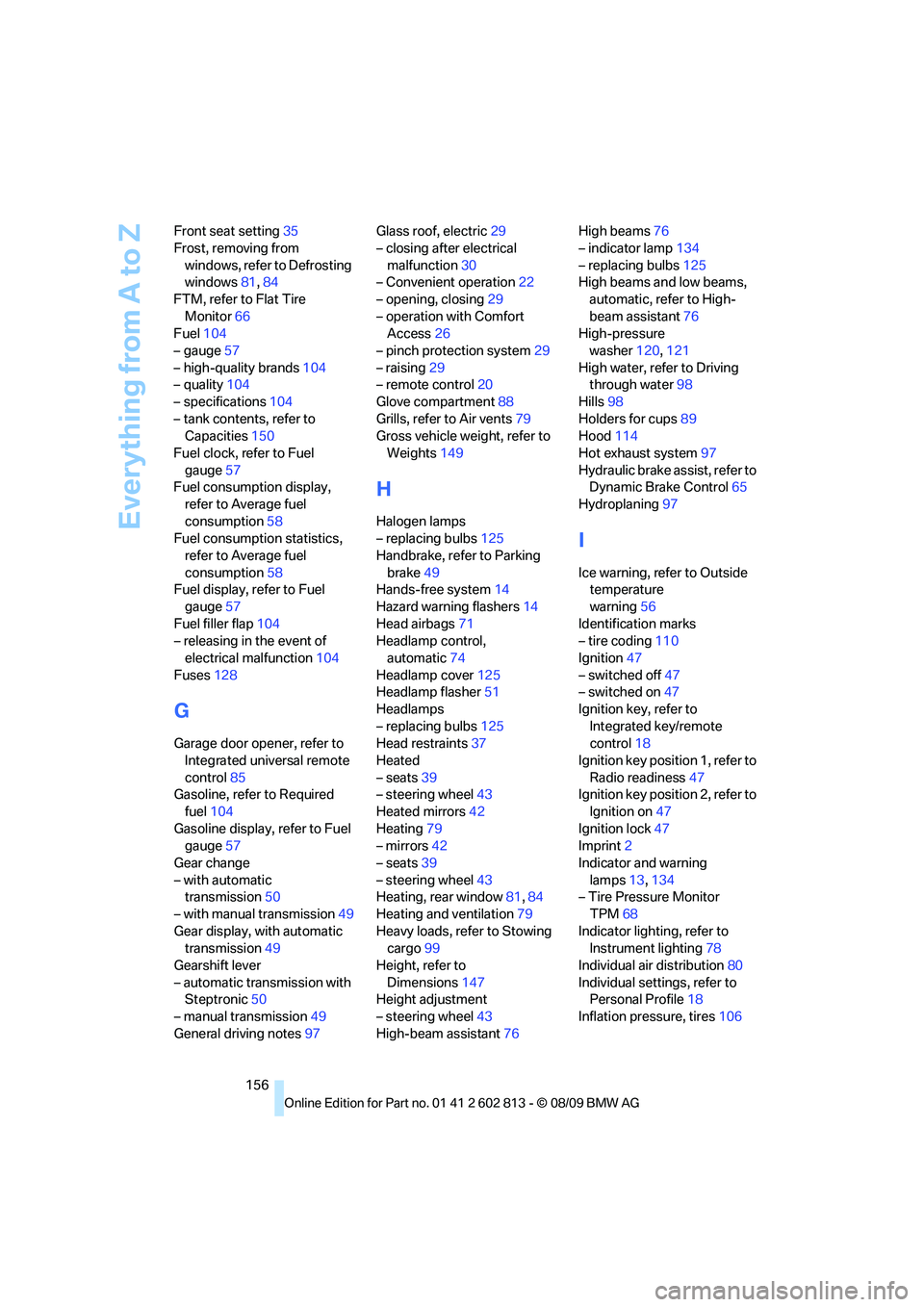
Everything from A to Z
156 Front seat setting35
Frost, removing from
windows, refer to Defrosting
windows81,84
FTM, refer to Flat Tire
Monitor66
Fuel104
– gauge57
– high-quality brands104
– quality104
– specifications104
– tank contents, refer to
Capacities150
Fuel clock, refer to Fuel
gauge57
Fuel consumption display,
refer to Average fuel
consumption58
Fuel consumption statistics,
refer to Average fuel
consumption58
Fuel display, refer to Fuel
gauge57
Fuel filler flap104
– releasing in the event of
electrical malfunction104
Fuses128
G
Garage door opener, refer to
Integrated universal remote
control85
Gasoline, refer to Required
fuel104
Gasoline display, refer to Fuel
gauge57
Gear change
– with automatic
transmission50
– with manual transmission49
Gear display, with automatic
transmission49
Gearshift lever
– automatic transmission with
Steptronic50
– manual transmission49
General driving notes97Glass roof, electric29
– closing after electrical
malfunction30
– Convenient operation22
– opening, closing29
– operation with Comfort
Access26
– pinch protection system29
– raising29
– remote control20
Glove compartment88
Grills, refer to Air vents79
Gross vehicle weight, refer to
Weights149
H
Halogen lamps
– replacing bulbs125
Handbrake, refer to Parking
brake49
Hands-free system14
Hazard warning flashers14
Head airbags71
Headlamp control,
automatic74
Headlamp cover125
Headlamp flasher51
Headlamps
– replacing bulbs125
Head restraints37
Heated
– seats39
– steering wheel43
Heated mirrors42
Heating79
– mirrors42
– seats39
– steering wheel43
Heating, rear window81,84
Heating and ventilation79
Heavy loads, refer to Stowing
cargo99
Height, refer to
Dimensions147
Height adjustment
– steering wheel43
High-beam assistant76High beams76
– indicator lamp134
– replacing bulbs125
High beams and low beams,
automatic, refer to High-
beam assistant76
High-pressure
washer120,121
High water, refer to Driving
through water98
Hills98
Holders for cups89
Hood114
Hot exhaust system97
Hydraulic brake assist, refer to
Dynamic Brake Control65
Hydroplaning97
I
Ice warning, refer to Outside
temperature
warning56
Identification marks
– tire coding110
Ignition47
– switched off47
– switched on47
Ignition key, refer to
Integrated key/remote
control18
Ignition key position 1, refer to
Radio readiness47
Ignition key position 2, refer to
Ignition on47
Ignition lock47
Imprint2
Indicator and warning
lamps13,134
– Tire Pressure Monitor
TPM68
Indicator lighting, refer to
Instrument lighting78
Individual air distribution80
Individual settings, refer to
Personal Profile18
Inflation pressure, tires106
Page 159 of 166
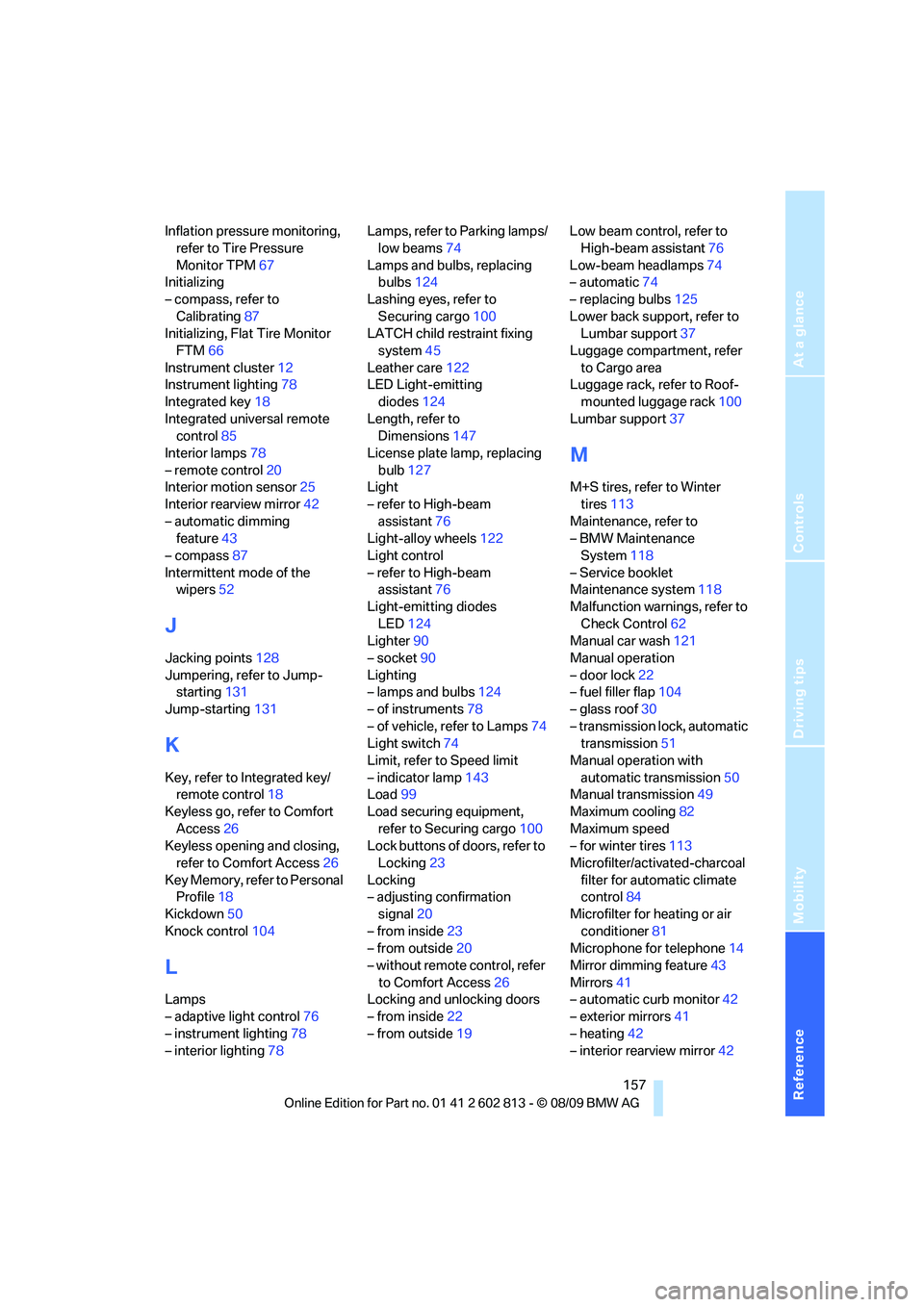
Reference
At a glance
Controls
Driving tips
Mobility
157
Inflation pressure monitoring,
refer to Tire Pressure
Monitor TPM67
Initializing
– compass, refer to
Calibrating87
Initializing, Flat Tire Monitor
FTM66
Instrument cluster12
Instrument lighting78
Integrated key18
Integrated universal remote
control85
Interior lamps78
– remote control20
Interior motion sensor25
Interior rearview mirror42
– automatic dimming
feature43
– compass87
Intermittent mode of the
wipers52
J
Jacking points128
Jumpering, refer to Jump-
starting131
Jump-starting131
K
Key, refer to Integrated key/
remote control18
Keyless go, refer to Comfort
Access26
Keyless opening and closing,
refer to Comfort Access26
Key Memory, refer to Personal
Profile18
Kickdown50
Knock control104
L
Lamps
– adaptive light control76
– instrument lighting78
– interior lighting78Lamps, refer to Parking lamps/
low beams74
Lamps and bulbs, replacing
bulbs124
Lashing eyes, refer to
Securing cargo100
LATCH child restraint fixing
system45
Leather care122
LED Light-emitting
diodes124
Length, refer to
Dimensions147
License plate lamp, replacing
bulb127
Light
– refer to High-beam
assistant76
Light-alloy wheels122
Light control
– refer to High-beam
assistant76
Light-emitting diodes
LED124
Lighter90
– socket90
Lighting
– lamps and bulbs124
– of instruments78
– of vehicle, refer to Lamps74
Light switch74
Limit, refer to Speed limit
– indicator lamp143
Load99
Load securing equipment,
refer to Securing cargo100
Lock buttons of doors, refer to
Locking23
Locking
– adjusting confirmation
signal20
– from inside23
– from outside20
– without remote control, refer
to Comfort Access26
Locking and unlocking doors
– from inside22
– from outside19Low beam control, refer to
High-beam assistant76
Low-beam headlamps74
– automatic74
– replacing bulbs125
Lower back support, refer to
Lumbar support37
Luggage compartment, refer
to Cargo area
Luggage rack, refer to Roof-
mounted luggage rack100
Lumbar support37
M
M+S tires, refer to Winter
tires113
Maintenance, refer to
– BMW Maintenance
System118
– Service booklet
Maintenance system118
Malfunction warnings, refer to
Check Control62
Manual car wash121
Manual operation
– door lock22
– fuel filler flap104
– glass roof30
– transmission lock, automatic
transmission51
Manual operation with
automatic transmission50
Manual transmission49
Maximum cooling82
Maximum speed
– for winter tires113
Microfilter/activated-charcoal
filter for automatic climate
control84
Microfilter for heating or air
conditioner81
Microphone for telephone14
Mirror dimming feature43
Mirrors41
– automatic curb monitor42
– exterior mirrors41
– heating42
– interior rearview mirror42
Page 160 of 166
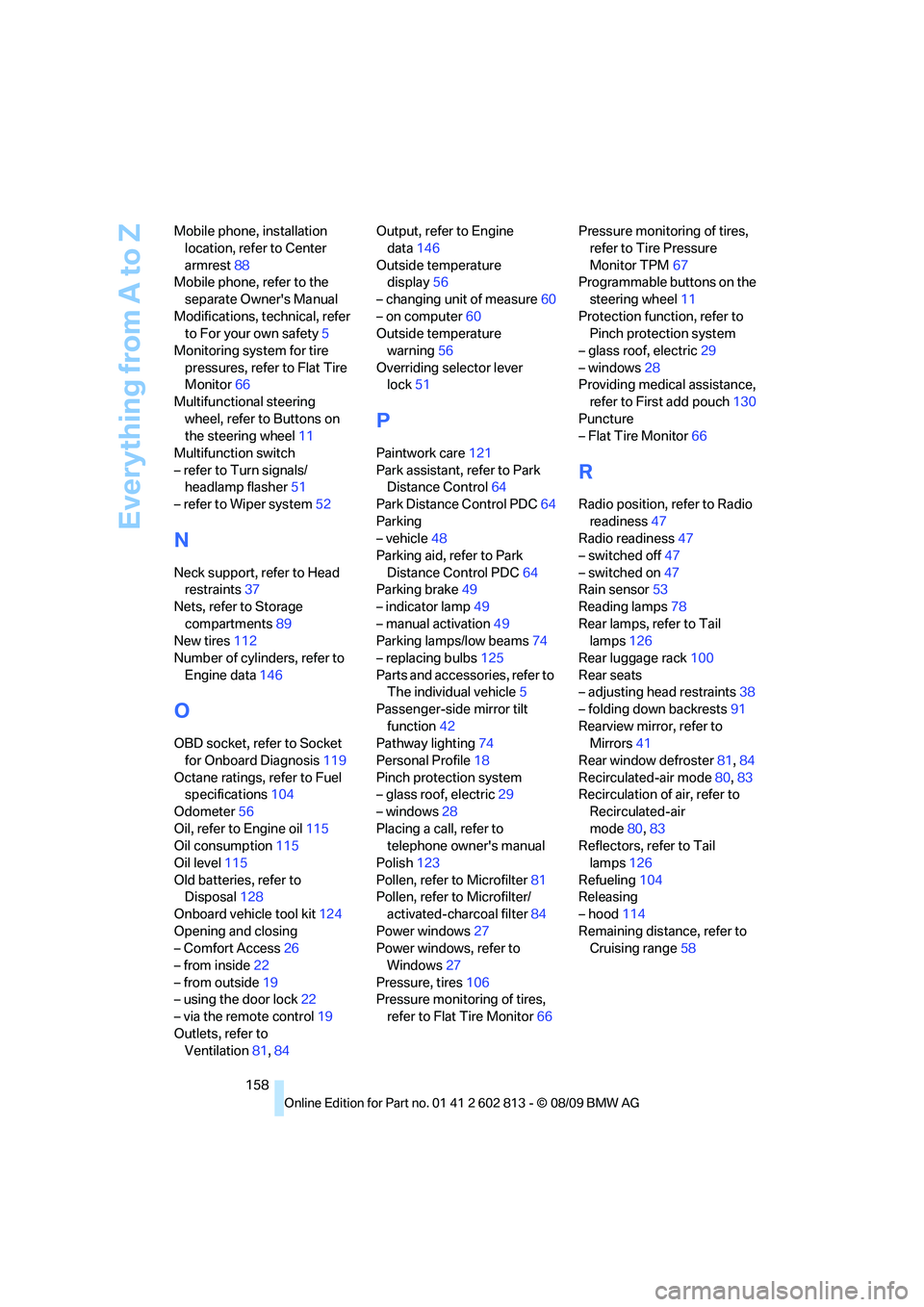
Everything from A to Z
158 Mobile phone, installation
location, refer to Center
armrest88
Mobile phone, refer to the
separate Owner's Manual
Modifications, technical, refer
to For your own safety5
Monitoring system for tire
pressures, refer to Flat Tire
Monitor66
Multifunctional steering
wheel, refer to Buttons on
the steering wheel11
Multifunction switch
– refer to Turn signals/
headlamp flasher51
– refer to Wiper system52
N
Neck support, refer to Head
restraints37
Nets, refer to Storage
compartments89
New tires112
Number of cylinders, refer to
Engine data146
O
OBD socket, refer to Socket
for Onboard Diagnosis119
Octane ratings, refer to Fuel
specifications104
Odometer56
Oil, refer to Engine oil115
Oil consumption115
Oil level115
Old batteries, refer to
Disposal128
Onboard vehicle tool kit124
Opening and closing
– Comfort Access26
– from inside22
– from outside19
– using the door lock22
– via the remote control19
Outlets, refer to
Ventilation81,84Output, refer to Engine
data146
Outside temperature
display56
– changing unit of measure60
– on computer60
Outside temperature
warning56
Overriding selector lever
lock51
P
Paintwork care121
Park assistant, refer to Park
Distance Control64
Park Distance Control PDC64
Parking
– vehicle48
Parking aid, refer to Park
Distance Control PDC64
Parking brake49
– indicator lamp49
– manual activation49
Parking lamps/low beams74
– replacing bulbs125
Parts and accessories, refer to
The individual vehicle5
Passenger-side mirror tilt
function42
Pathway lighting74
Personal Profile18
Pinch protection system
– glass roof, electric29
– windows28
Placing a call, refer to
telephone owner's manual
Polish123
Pollen, refer to Microfilter81
Pollen, refer to Microfilter/
activated-charcoal filter84
Power windows27
Power windows, refer to
Windows27
Pressure, tires106
Pressure monitoring of tires,
refer to Flat Tire Monitor66Pressure monitoring of tires,
refer to Tire Pressure
Monitor TPM67
Programmable buttons on the
steering wheel11
Protection function, refer to
Pinch protection system
– glass roof, electric29
– windows28
Providing medical assistance,
refer to First add pouch130
Puncture
– Flat Tire Monitor66
R
Radio position, refer to Radio
readiness47
Radio readiness47
– switched off47
– switched on47
Rain sensor53
Reading lamps78
Rear lamps, refer to Tail
lamps126
Rear luggage rack100
Rear seats
– adjusting head restraints38
– folding down backrests91
Rearview mirror, refer to
Mirrors41
Rear window defroster81,84
Recirculated-air mode80,83
Recirculation of air, refer to
Recirculated-air
mode80,83
Reflectors, refer to Tail
lamps126
Refueling104
Releasing
– hood114
Remaining distance, refer to
Cruising range58